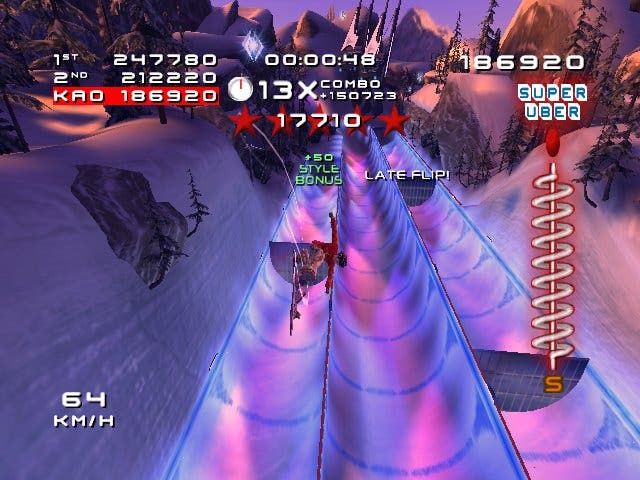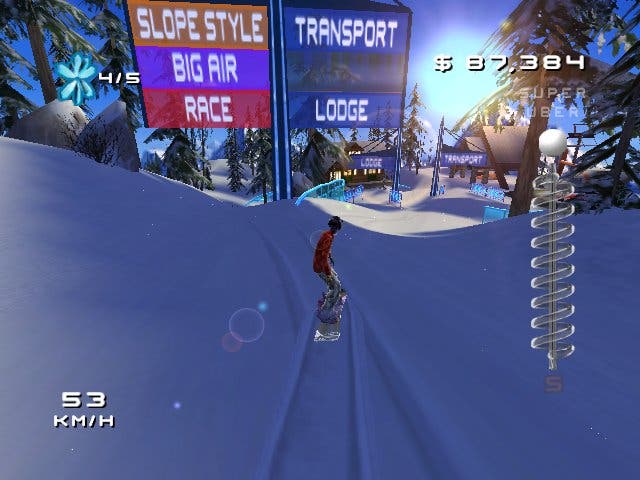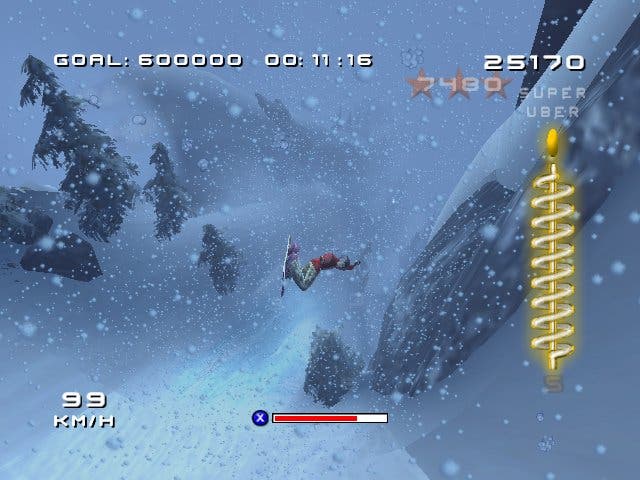SSX 3
Winter's closing in, so why fight it?
Ever since Grand Theft Auto III arrived in our PS2 trays, a "seamless" gaming environment has become a very attractive option, and not just for grisly cop dramas and action games either - Naughty Dog used it to great effect in Jak II: Renegade, Treyarch plans to use it in Spider-Man 2, former Spider-Man handler Neversoft has borrowed it for Tony Hawk Underground, and even the mighty EA is now peddling its own tribute to the Scottish-born Godfather of free-roam gameplay. Welcome to SSX 3, where menus are taboo and you can "go anywhere".
SSX Rips Off GTA (No, hang on)

To describe SSX 3 as "SSX rips off GTA" though would be incredibly unfair, because after a few long days of grinding, grabbing and pondering the word "uber", the two-year-old SSX Tricky feels very odd to our fingers, and the lack of certain features debuted in SSX 3 leaves its once-illustrious predecessor feeling rather hollow and alien. Which is a good sign! After all, sequels are judged mainly on how thoroughly they banish thought of their predecessors. Far from a hangover, SSX 3 is a very different game to see, hear, play and master.
To pick it up and go though, you wouldn't realise this. Faced with Single Event, Conquer the Mountain and Multi Play options (and Online if you have the PS2 version, which we'll be taking a proper look at very soon), it all seems fairly familiar. Although events are split across the three 'peaks' of EA's fictitious mountain resort, they all fall into the familiar Race, Slopestyle and Free Ride templates, are generally unlocked sequentially (with certain broad requirements to unlock the next actual peak), and, although many now vary in length and focus, can be overcome much the same way as ever before - building up boost by flipping and grabbing off regularly placed jumps, grinding on rails and overtaking people, and completing each in several heats. We didn't even learn any new tricks for about five hours and still made steady progress.
The fact that each event is accessed by boarding in the direction of the start (located at the bottom of an unmarked mountain route full of natural disasters waiting to happen) and not just hitting a button on a menu is almost inconsequential - and besides, if you're in the lodge area grinding a few park benches, or you've just finished a race, you can choose the "Transport" option from the menu to copter your way between events (complete with load screen animation). So much for knocking down the fences, eh?
But oh how we ate our initially rather passionless notes on the subject after we got to the top of the third peak. You see, not only has EA BIG made an SSX game that recaptures the fast pace, ridiculous trick systems and inspirational track design of its predecessors, the dev team has managed to work it into a much more imaginative framework, flesh it out with all manner of gameplay improvements (rather than simply "additions") and, yes, they've strung it together properly and battered down the boundaries. Sure, you can jet between events using the menus from time to time, but isn't that an important feature missing from games like GTA, rather than one that belies the SSX' free-roaming premise? It makes more sense than hopping in a conveniently placed taxi, anyway.
Seams Good

SSX does the seamless environments thing in its own way, allowing you to enjoy the untracked "backcountry" areas above each peak's lodge and starting blocks, scouring every area of the game for hidden bonuses (like snowflake icons, each of which is worth a couple of thousand dollars hard currency), turning Free Rides into THPS4-style career levels with individual challenges to locate and then complete, racing and tricking one-on-one against rivals through various stretches of the mountain, and even racing from the top of the mountain to the very bottom for the 30-minute-long finale. And it does all of this without betraying the series' strengths - the screw-up/pause/restart approach to carving your way through each 'extreme' gauntlet, and the multi-layered trick system.
After Tricky of course, everyone was expecting more of the word "uber" and probably more of Run DMC, but EA has obviously had a bit of a rethink. (Maybe Run DMC are more expensive these days - death sells) So, this time we've got three degrees of uber trick to acquire, from basic feet-off-the-board tricks to super-ubers (the sort of shameless, astonishingly cool mid-air antics that made Tricky seem completely ridiculous), and you can even perform uber tricks on rail grinds - although you'll obviously come severely unstuck if you slide off the end of a rail whilst doing a headstand on your board. In fact, uber tricks are so commonplace now that they get no sort of special musical accompaniment - just a gravely voice over and some on-screen kudos.
This time you can even buy and equip new uber tricks from the Lodge area shop, and there are tons of these - so many that it'd take hours to test each one thoroughly, and that's if you had the necessary cash total to start with, which you won't, particularly as attribute points now have to be bought (eating into your winnings) rather than earned through bronze, silver and gold medals. Of course this means that, in theory at least, with a bit of exploration and snowflake-collection you could max out a rider before you even graduate to the shiny silver skill level, but in reality the rewards for progress are sensibly spaced and weighted for each accomplishment. It's not going to be like turning up to a Vauxhall Nova track meet in a Maclaren F1, and nor should it be.
Superfluous Uber!

Increasing the number of uber tricks though was hardly a major change for EA BIG, which is why we're pleased to be introducing a much more clear-cut combo system, board presses, handplants and a refined boost system as well. Instead of 'hiding' masses of yellow, orange and red snowflake icons in the air above each track to multiply your trick scores, this time EA has sprinkled multiplier icons farther and wider than ever before, and kept them to a minimum - partly because it's more fun this way, and partly because now you can keep a combo going literally the whole way down the mountain (as one EA Canada tester reportedly did for a group of visiting journos...), and adding multipliers constantly would be insanity itself.
But what's that you say? Combos? Yes! You can now keep them going for, well, not hours, but several minutes at least, and for that we owe a lot of thanks to the additions of board pressing and the combo timer. Board pressing is a silly, ambiguous name, as you can see - but then so is "manualling" in Tony Hawk's and "buttering" in Amped 2. What 'board pressing' brings to the game is the ability to link chains of big jumps, grinds and other tricks by leaning on the back or front edge of the board. By alternating between holding the right analogue stick forward and back, it's possible to 'board press' between a perfect landing and the next big jump, keeping a combo alive and reaping the benefits of doing so on the next landing. And there's no standard-issue swing meter here to keep an eye on, nudging it back and forward to stop you bailing - board pressing is a lot easier than its counterparts in other extreme sports games, and relies on rider animations to show you losing your balance.
But board pressing would be next to useless if it wasn't for the combo timer, which shows you very plainly how much time you've got between landing a trick or letting go of that board press before you have to start the next move. If the little four-stroke clock ticks fully red, then you bank whatever multiplier or points total you had accumulated and have to start over. If it's less than full when you leap from the next ramp, grind the next rail or perform your next board press, then the total keeps on rising. As you can imagine then, finding one of the traditional "5x" multiplier snowflakes in the grip of a sprawling combo is hugely satisfying. And although the other introductions (a boost bar that only spills small chunks of juice when you make a mistake, and handplants that let you move between parallel rails and reach the highest half-pipes) are less significant, they're both sensible changes in their own way. Mapping handplants to the awkwardly placed white and black buttons wasn't sensible, but, like we said, they're not hugely significant.
Still Tricky

What's perhaps best about the new SSX though is that, for all these new changes, you can still pick it up and play it the way you played Tricky. You'll even get quite some way - you could certainly max out a character and get bronze medals on the third peak's toughest tasks without a single board press, handplant or massive combo. But to get the most out of the game you will need to explore the big changes thoroughly. As a newcomer, it's the sort of game that could take years to truly unravel. With this in mind, then, the lack of a dedicated Tutorial mode is something of an oversight, but thankfully your M-Com PDA (don't worry, she's not saying "Enron!" when you hit Pause), which operates all the menus and suchforth, feeds you various tips and challenges directly. Still, in the absence of a printed manual, we only found out about some of the game's advances on the internet, and that's not good. Especially as most of you don't read manuals at all.
You can do plenty of other things with your M-Com, of course, like buying items from the lodge (apart from attributes and uber tricks, which are the only things that affect your rider's abilities, you can buy different hats, hairstyles, eyewear, clothing, and even dodgy heads and new boards to serve your rider's vanity), and checking out how much of the game you've unlocked, how many snowflake icons remain, how many medals you have, how many "career highlights" you've achieved (whether you've managed to do 10 grind ubers in a single event, or pulled a 20x combo), etc. You can even toy with Radio BIG, the humourlessly MCed frontend for this year's selection of funky beats - although SSX 3 is crying out for a "Custom Soundtrack Radio" option, rather than just the option to buy up existing tracks with 'song points' and mould them into your own playlist. Still, most of the tracks aren't hugely objectionable - there's even some Jane's Addiction and Placebo on there. Er, yeah, best not ask me about music in future...
So: M-Com, Radio BIG, seamless levels, an overhauled trick system... gorgeous visuals? Of course. Holding the whole package together is one of the smoothest and most deliciously detailed and animated gaming environments ever conceived. If you've seen either of the previous two games then you know EA's capable of some beautiful design and animation because you simply won't have noticed the transition when a jump segues into a tumble or a grind becomes a jump. The same is still true - the word 'seamless' definitely deserves another application here - and now EA's matched it to some truly massive draw distances, typically colourful environments, far more clear cut, grindable objects, beautiful weather effects (which even affect gameplay, as a windswept second peak backcountry area has you being blown round corners), tons more traditionally paper-thin characters, and a lightning frame rate.
On the latter point, it's around about when you're streaking down the new city track for the first time, weaving through buildings on rails and plunging through glass ceilings and off precipices, that it first occurs to you that SSX 3 moves at a much faster pace than either of the first two, and although the city track is ironically one of the few areas of the game home to slowdown, it's a good example of how accommodating the game can be. It's a lot faster, yes, but it's also a lot more forgiving, right down to a new Recovery bar, which invites you to tap X quickly when you're tumbling through the snow or plummeting to earth and perhaps right yourself in time to save face and even salvage a couple of flips before you land...
Highs and Lows

Track design is also very accommodating. In fact, as SSX 3 landed on our desks we were still finding new ways to beat the tracks in Tricky, and there seem to be more shortcuts, secret routes, aerial grinds and other nuggets to unlock in this one - and even the obvious way through a track is a lot smoother and more intelligently put together than before. One early example would be a 'Slopestyle' track with plenty of rails. While these rails aren't connected, they're perfectly spaced to let you grind, uber grind, perform jump tricks between and generally swoop and swing from start to finish. Thanks to the complex and detailed rail design, it was the first track we managed to combo from top to bottom - and yielded our highest points total to date. Far from being a one off, this is par for the course - SSX 3's track design is always genius, and varies hugely from course to course. It made us forget entirely about Amped 2, not to mention Tony Hawk Underground, both of which are lying unloved on our coffee table as SSX' N.E.R.D. song swears "it's almost over now".
And it is almost over now for you, my lovelies, because all that's left is a collection of our hard-earned criticisms. For, undeniably brilliant though SSX 3 is, there are still a few points we'd like to raise.
Number one, and without question the thing we swore about most, is the use of the X button for boost and tweaks. Tweaks, as you may remember, are used to add a different flavour to a trick, bending the legs a bit in mid-air to accentuate a grab, etc. Anyway, the key fact about tweaks is that if you are tweaking as you land, you will land badly and lose your points, poise and, soon, patience. Why? Because the chances are that the main thing you're going to be worrying about whenever you land is boosting, and it's hardly surprising that the two activities regularly overlap to agonising effect. Screeching down a slope mid-combo and reaching for the boost button, you'll almost certainly find yourself holding it as your rider skips off a bump at least a few times, forced to watch in agony as he or she tumbles and loses all your hard work. You could probably avoid it if you paid close attention, but you're usually concentrating on what to do off the next jump when it happens.
Our other issues are somewhat less important, but still deserve mention. For a start, there is still a tendency to get caught on the scenery from time to time, or literally jammed between a rock and a hard place, bumping back and forward unhelpfully as the camera has a fit - forcing you to press the Back button to right yourself. The cost? Any boost you had stored up. Given that it's a flaw in the game, it's way too high a price to pay. We also have a few harsh words for the occasional 'leap of faith' necessary to find a new area, the distinct lack of signposting around the boundaries, and the camera in general. On that note, we would've liked to see a 'pull it directly behind me' button, particularly, although we're sympathetic on the grounds that SSX 3 uses every button on the pad without exception...
Cool Boarders
As must be plainly obvious by now, we've invested more time and love in SSX 3 than we've given a whole collection of other games lately. It's just so massively detailed, so thoroughly improved and so gloriously playable that we have to recommend it. We haven't even touched on the multiplayer aspect, which we'll be doing in our PS2 Online review very soon, but to be honest it wouldn't have to be good - the rest of the game is enough on its own.
Sequels are ubiquitous these days, so to find one, which builds so expertly on what's come before, offering enough for old and new gamers alike is truly something to get excited about. If you have a distinct aversion to "baggy pants" sports games or quiver at the sign of complex control schemes then you'll probably want to pass, but even for the most ardent extreme sports enthusiast, this is an essential purchase. And to any actual snowboarders out there currently snorting in derision - get over your preconceptions, because we feel sure you'd take relentless entertainment over realism any day of the week, and that's what SSX 3 offers.


